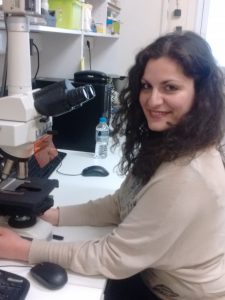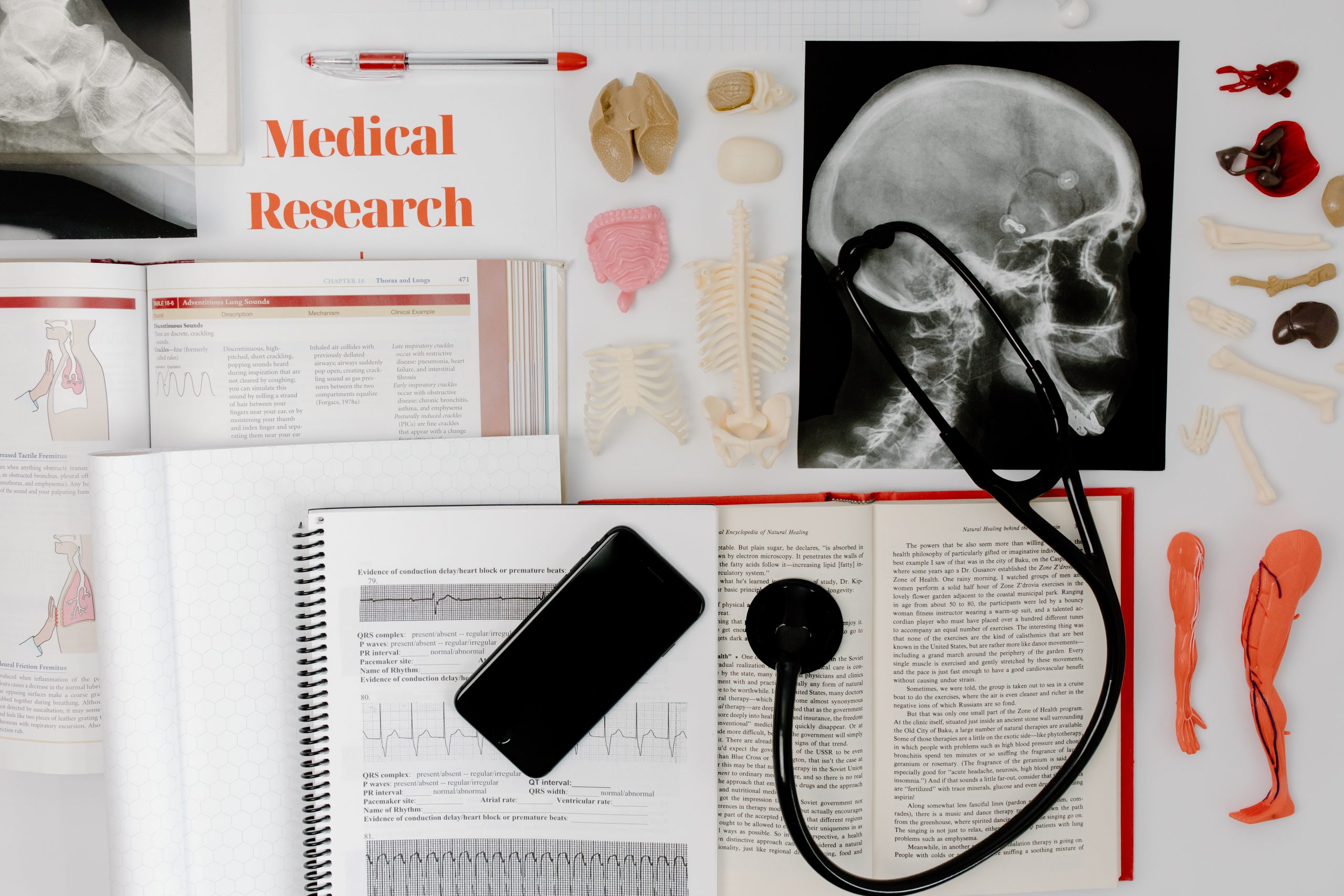AUTHOR’S CORNER
Fighting against cancer and Alzheimer’s
SHARE
Dr. Barbara Mavroidi begun her studies in the Chemistry Department of the National and Kapodistrian University of Athens, where she also acquired her master and doctoral degrees. Her career so far includes publications in peer-reviewed scientific journals, many scholarships and a patent. Today, she is a post-doctoral researcher at the Institute of Biosciences & Applications, at the Laboratory for Structural Studies of Biomolecules and Pharmaceuticals, working with Dr. M. Pelekanou.
The primary subject of her studies is about compounds for the diagnosis and cancer therapy and neurodegenerative diseases, such as Alzheimer’s. Her work further includes the biological evaluation of natural products used as photodynamic and photoprotective agents against cancer and photoaging, by collaborating with other Institutions and research groups, as well as private companies.
In simple words, what are the pharmacological studies you perform to evaluate chemical compounds directed against cancer and Alzheimer’s?
The standard steps we follow for the design and development of new compounds with pharmacological interest include the choice of a lead compound, the chemical synthesis and the biological evaluation. The first step is the choice of the lead compound, i.e. a chemical structure with specific chemical and structural characteristics that acts as the core of the drug. We choose lead-compounds from a variety of tested drugs and natural compounds. At the same time, we can also alter the core to create new compounds with maximum biological effect. In the past few years, our lab has been studying both synthetic and natural products as potent drugs against neoplasia and neurodegenerative diseases. Our studies cover the whole development process, from the chemical synthesis of lead compounds to the biological evaluation of the drug candidates based on cellular and animal models.
 One of the compound families you study as potent anticancer drugs are natural products, such as curcumin, isatin, etc.. Why is it important to study these molecules?
One of the compound families you study as potent anticancer drugs are natural products, such as curcumin, isatin, etc.. Why is it important to study these molecules?
The use of natural compounds and their derivatives as anticancer drugs is attracting more and more attention from the scientific community, mainly because of their low manufacturing cost. These natural compounds are in fact an unlimited source of raw materials for future drugs. In our lab, we have observed that natural products, such as curcumin, isatin, kersertin, can kill various cancer cells through the mechanisms of apoptosis and necrosis or by destroying the DNA of these cells. At the same time, the combination of natural products with widely used anticancer drugs can improve dramatically the anticancer activity of the latter, while keeping their toxicity towards healthy cells to a minimum. That explains why many natural compounds or derivatives are in preclinical or clinical phase.
You have studied the potency of natural compounds both in their natural form and when they are enclosed in certain structures, such as nanoparticles or liposomes. Could you describe the different approaches used in these two versions of the compounds?
As I mentioned before, there are many natural compounds exhibiting a wide range of pharmacological activity against cancer, infections, inflammation etc. Nevertheless, their success in the clinic is less impressive, partly due to their low availability and solubility. Because of this, the drug cannot reach high concentrations in the blood circulation and so only small amounts of it reach the target (cancer cell, inflammation point etc).
Nanotechnology can give us a solution to this problem. Incorporating these drugs in nanocarriers (called nanoparticles), we can deliver the drug to the blood circulation, increase its bioavailability in certain parts of the body, and control its release from the carrier at the same time. Their ability to target specific parts of the body is a result of their combination with antibodies, proteins, peptides etc. Despite the many advantages of the nanocarriers, their induced toxicity hampers their application in the clinic. Our personal goal as research lab is to successfully incorporate natural compounds into non-toxic nanocarriers that target effectively and specifically, with the minimum side-effects.
Can you explain what the relation between the beta amyloid plaques and the Alzheimer’s disease is? Is there a good diagnostic tool to diagnose Alzheimer in patients today?
Alzheimer’s disease is an example of a very well-known disease of the central nervous system, which is non treatable, deathly and the major cause of dementia (70% of the total dementia cases). One of the main histopathological characteristics of the disease is the presence of amyloid plaques in the extracellular domain of the brain. The main ingredient of the amyloid plaques is the b-amyloid peptide, which under non established, yet, circumstances aggregates into the-so called- amyloid fibers. Amyloid fibers are non-soluble and so over time they accumulate in the brain causing alterations that are believed to correlate with the pathology of the disease.
The fact that today, there is no reliable method to diagnose early stages of the disease, have pushed us to research compounds for that particular matter.
When it comes to therapy, we are trying to develop molecules-inhibitors (synthetic or natural) that can hinder the aggregation of the b-amyloid peptide. At the same time, we try to develop radio-diagnostic tools, meaning durgs that are also radioactive and can be used for diagnosis (in collaboration with IPRETEA) for the early and selective diagnosis of amyloid plaques in the brain, using tomography.
Can you share with us the scientific results that pushed you to patent your findings on the diagnosis of Alzheimer’s?
Our research group (consisting of Dr. M. Pelekanou, Dr. M. Sagnou, Dr. M. Papadopoulos, Dr. I. Pirmettis, Dr. A. Shegani and myself) were very happy to file a Greek and international patent for our work on benzothiazole complexes with radioactive cyclopentadienyl technetium 99m and rhenium. These compounds exhibit an extraordinarily high penetration of up to 8% of the Blood Brain Barrier (BBB). That characteristic makes them perfect candidates for the treatment of Alzheimer’s disease and other neurodegenerative diseases. Besides the penetration of the BBB, these compounds exhibit two important advantages. First, the chemical affinity of technetium 99m with the amyloid plaques makes the compounds excellent diagnostic and imaging tools. Second, their strong affinity with the amyloid fibers has inhibited the toxicity of the b-amyloid peptide in cell cultures. Given that the BBB is hard to penetrate, one can easily understand the value of these results to help fight brain diseases.
Your research group has established collaborations with companies in the last years, to develop compounds with pharmacological potency. Why is it important for a scientist to collaborate with companies and what have such collaborations offered to you?
Under an action by the Program of Industrial Scholarships of Stavros Niarchos Foundation in collaboration with N.C.S.R. Demokritos, I had the opportunity to collaborate as a post-doctoral researcher with the radiopharmaceutical product company, Biocosmos and quite recently with the natural products company Pharmagnose. My collaboration with Biocosmos resulted in the development of a novel radio-diagnostic tool of technetium 99m with the benzothiazole derivative for the early diagnosis and potentially treatment of breast cancer. For the collaboration with Pharmagnose, I am studying the use of natural products as photoprotecting agents for medical and beauty products.
Basic research is always a valuable tool and an absolute requirement to understand and resolve the various biological riddles; however, it is crucial for research bodies grasp the needs of the market. Sadly, state funding in Greece is insufficient , so we need to collaborate with the private sector. Personally, I have acquired many positive experiences from these collaborations, as I had the chance to further develop my professional skills and better understand the production process. What is more, when you collaborate with private companies you can have a greater chance to get European and Greek scholarships.
You have personally engaged with actions concerning science education to children. What was your experience? How important is for the scientists to interact with the wide audience?
Since 2013, I had the pleasure to participate in different educational activities that have been organized by the N.C.S.R. Demokritos, such as the “Scientist Night”, in the “Athens Science Festival” and in some BASF’s actions, such as the “Summer Scientific Laboratories”, organized by the Institute of Biosciences and Applications. The purpose of these actions is to communicate science to a wide audience, specifically primary and secondary school students. My experience is incredibly valuable, specifically now that I am a mother, since it has helped me to realize how easily one can explain even the most complicated scientific facts using games and creative discussions with children. The feeling of satisfaction and content is remarkable. In the very end you are turning into a child yourself!
What would you advise someone interested in working for the research and development of drugs?
Drug development research is laborious and requires persistence and focus and hard work. Scientists in Greece have to face further practical difficulties that make our work even harder and sometimes discourage us. Because of the uncertainty of the work environment, many of us choose the private sector, which at least ensures financial stability. Nevertheless, we have to admit that we are employees who are very passionate with our work, since we have made our dream as an everyday job and we can also get spiritual and ethical satisfaction. This is truly a blessing and at the same time, a huge motivation to overcome all the obstacles.

RELATED ARTICLES

What is the color of radioactivity?
When Greek Women in STEM go to the movies

Women in STEM : A Brief Review
Women and girls make up half of the world’s population, and make up 50% of their total potential and talent.

Archive
Find all our past articles chronologically organized in our archive.
CONTACT US
____________
greekwomeninstem@gmail.com
Do you have ideas, questions, comments or special requests?
Would you like to highlight your research project or nominate a researcher that you would like to learn more about?
Please write to our email or fill out the form and hit “send”. We will be happy to talk with you!
[contact-form-7 id=”44″ title=”Contact form 1″]

